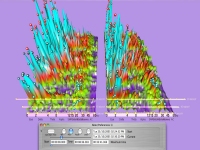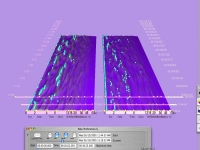What is hypnosis - a few theories to consider
|
Current research
|
Awake / alert / eyes open
 In a deep trance state
In a deep trance state

|
|
Current research strongly suggests that when in a trance state there are substantial & measurable changes in terms of brain activity. (See above).
|
|
Perhaps the important thing to understand about the concept of hypnosis is that much is not understood. This is however the case with most topics within the realm of psychology - the important thing to remember is that hypnotherapy is an effective solution for many issues. Exactly how the concept of hypnosis fits into the overall process of change does not really matter. Hypnosis helps to generate change and has been doing so for a very long time. (More info on the history of hypnosis and hypnotherapy...)
1 MODIFIED SLEEP THEORY
The modified sleep theory was defined by James Braid in 1819. He proposed that fixed attention results in a nervous sleep and the creation of a state in which the patient may be readily influenced. He postulated that amnesia would always follow (which is however often not the case). It was also his contention that the process is with the client not to the client.
2 PSYCHOANALYTICAL THEORY
Freud proposed that hypnosis is the closing down of brain function and the reversion to a childlike state. He claimed that hypnosis returns the patient to a childlike state, a state in which the ego function of the brain is suspended. He claimed that the patient is under the pressure of a therapist, that the therapist is equivalent to the patients father. He likened hypnosis to the concept of falling in love.
But this theory does not explain fixed point trance states. In which, the patient enters into a hypnotic state without requiring the intervention of an therapist (e.g. when driving).
3 CONDITIONED REFLEX THEORY (PAVLOV)
The conditioned reflex theory was proposed by Pavlov. He proposed that hypnosis is a conditioned response to the word SLEEP.
But, as demonstrated by fixed point trance induction the word sleep is not required in order for a patient to enter into a hypnotic state.
4 DISASSOCIATION THEORY (JANET 1925)
The disassociation theory was proposed by Professor Janet in 1925. Janet claimed that hypnosis involves splitting the mind into two parts, thereby making the unconscious mind dominant. Janet believed that hypnosis causes conscious amnesia in all cases.
But, given that amnesia does not always occur, this theory is flawed.
5 PHYSICAL THEORY (BARRIE WYKE)
The physical theory was proposed by Barrie Wyke in 1957. He proposed that by closing off various sensory functions, susceptibility to suggestion would result. Closing off sensory input does create an altered state of consciousness. But this is not the entire picture.
6 SUGGESTION THEORY (BERNHEIM)
The suggestion theory was introduced by Bernheim in 1886. He proposed that all trance is induced by simple suggestion. He claimed that the "critical" functioning of the brain is put to one side and that suggestion is taken as truth without question.
But you do not have to be susceptible to suggestions in order for trance to be induced.
7 ROLE PLAYING THEORY (RW WHITE)
The role playing theory was introduced by RW White in 1941. White proposed that hypnosis is a striving by the patient towards the attainment of a certain goal ie acting out / role playing what that person understands as being hypnosis. It was his contention that the patient is playing the role of patient.
But this does not explain analgesia / anaesthesia.
8 ATAVISTIC REGRESSION THEORY (AINSLEY MEARS)
Atavistic regression was introduced by Ainsley Mears in 1960. It was his contention that hypnosis means and a reversion to an earlier age. He proposed that the higher functions of the brain are switched off and that we revert to basic flight/fright immobility reflex instincts and that our logic processing alters such that we accept basic/literal logic.
CONCLUSION
There are many theories that have sought to explain hypnosis. It is probable however that they are all equally valid in different circumstances.
It is of course wise to reiterate that our understanding in terms of exactly how the brain operates remains limited. (More...)
Current research using MRI scanners is just beginning the process of defining what happens when we enter trance states. (More info on MRI scans during a hypnotherapy session...)
|